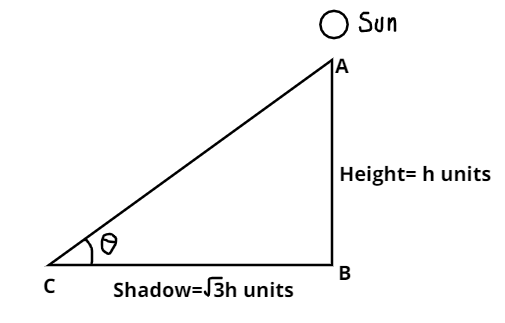
The angle of elevation of the sun when the length of the shadow of pole is $\sqrt 3 $
times the height of the pole is
\[
(A){\text{ 3}}{{\text{0}}^0} \\
(B){\text{ 4}}{{\text{5}}^0} \\
(C){\text{ 6}}{{\text{0}}^0} \\
(D){\text{ 1}}{{\text{5}}^0} \\
\]
Answer
219.6k+ views
Hint: Draw figure and then use trigonometry identity $\cot \theta = \dfrac{{Base}}{{Perpendicular}}$.

Let AB be the height of the pole and BC be its shadow.
As, we are given the ratio of the length of the pole and its shadow.
Let the height of the pole be AB$ = h$ units.
So, the length of its shadow will be BC $ = \sqrt 3 h$ units.
So, we must find an angle of elevation.
Now, we can only use the given condition.
So, the best way to find the angle of elevation using trigonometric formulas.
So, solving using given conditions.
Let, $\angle ACB = \theta $.
And , \[\theta \] will be the angle of elevation of sun
And we know that $\cot \theta = \dfrac{{Base}}{{Perpendicular}}$.
Here, the base will be BC.
And, perpendicular will be AB.
So, here putting the value of base and perpendicular in $\cot \theta $ we will get.
$\cot \theta = \dfrac{{BC}}{{AB}} = \dfrac{{\sqrt 3 h}}{h} = \sqrt 3 $
So, from the above equation we can write,
\[\theta = {\cot ^{ - 1}}\left( {\sqrt 3 } \right)\] (1)
Using inverse trigonometric formulas. We can say that $\theta = {30^0}$
Hence, the angle of elevation of the sun will be ${30^0}$.
Hence, the correct Option will be A.
Note: Whenever we come up with these types of problems, first we should draw the figure according to the given conditions in question, then we will use the trigonometric functions to get the angle of elevation which will be the easiest and efficient method. And we should remember that object and its shadow are always perpendicular to each other.

Let AB be the height of the pole and BC be its shadow.
As, we are given the ratio of the length of the pole and its shadow.
Let the height of the pole be AB$ = h$ units.
So, the length of its shadow will be BC $ = \sqrt 3 h$ units.
So, we must find an angle of elevation.
Now, we can only use the given condition.
So, the best way to find the angle of elevation using trigonometric formulas.
So, solving using given conditions.
Let, $\angle ACB = \theta $.
And , \[\theta \] will be the angle of elevation of sun
And we know that $\cot \theta = \dfrac{{Base}}{{Perpendicular}}$.
Here, the base will be BC.
And, perpendicular will be AB.
So, here putting the value of base and perpendicular in $\cot \theta $ we will get.
$\cot \theta = \dfrac{{BC}}{{AB}} = \dfrac{{\sqrt 3 h}}{h} = \sqrt 3 $
So, from the above equation we can write,
\[\theta = {\cot ^{ - 1}}\left( {\sqrt 3 } \right)\] (1)
Using inverse trigonometric formulas. We can say that $\theta = {30^0}$
Hence, the angle of elevation of the sun will be ${30^0}$.
Hence, the correct Option will be A.
Note: Whenever we come up with these types of problems, first we should draw the figure according to the given conditions in question, then we will use the trigonometric functions to get the angle of elevation which will be the easiest and efficient method. And we should remember that object and its shadow are always perpendicular to each other.
Recently Updated Pages
The maximum number of equivalence relations on the-class-11-maths-JEE_Main

A train is going from London to Cambridge stops at class 11 maths JEE_Main

Find the reminder when 798 is divided by 5 class 11 maths JEE_Main

An aeroplane left 50 minutes later than its schedu-class-11-maths-JEE_Main

A man on the top of a vertical observation tower o-class-11-maths-JEE_Main

In an election there are 8 candidates out of which class 11 maths JEE_Main

Trending doubts
JEE Main 2026: Application Form Open, Exam Dates, Syllabus, Eligibility & Question Papers

Derivation of Equation of Trajectory Explained for Students

Hybridisation in Chemistry – Concept, Types & Applications

Understanding the Angle of Deviation in a Prism

Understanding Collisions: Types and Examples for Students

Understanding Atomic Structure for Beginners

Other Pages
JEE Advanced Marks vs Ranks 2025: Understanding Category-wise Qualifying Marks and Previous Year Cut-offs

NCERT Solutions for Class 11 Maths Chapter 10 Conic Sections

NCERT Solutions for Class 11 Maths Chapter 9 Straight Lines

NCERT Solutions For Class 11 Maths Chapter 8 Sequences And Series

How to Convert a Galvanometer into an Ammeter or Voltmeter

NCERT Solutions For Class 11 Maths Chapter 12 Limits And Derivatives




